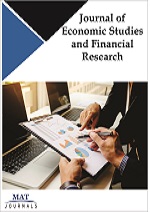Effect of Macroeconomic Factors on the Exchange Rate (USD/LKR) in Sri Lanka: An Empirical Analysis using Time Series Models
DOI:
https://doi.org/10.46610/JESFR.2025.v06i02.002Keywords:
Autoregressive distributed lag model, Exchange rate, Long run & short run relationships, Stationarity, Trade balanceAbstract
This study examines the impact of macroeconomic factors on Sri Lanka's Exchange Rate (ER) using monthly data from January 2013 to January 2023. Amid growing economic instability, ER fluctuations threaten resilience and sustainable growth, underscoring the need to identify key influencing factors. Advanced econometric analyses were conducted using secondary data from the Central Bank of Sri Lanka and the Department of Census and Statistics. The ARDL (2, 0, 2, 1) model emerged as the best fit, revealing inflation (INF) as a significant long-run determinant positively impacting ER, while trade balance (TB) also plays a crucial role. Interest rates (IR) negatively influence ER but lack statistical significance in level data. The study highlights that managing inflation, fostering trade, and ensuring stable interest rate environments are critical strategies for policymakers. Additionally, diversifying exports, fiscal consolidation, and enhanced risk management are vital for mitigating external uncertainties and promoting economic stability.




